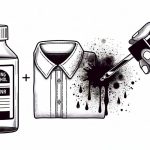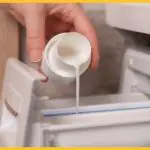If you're looking to remove vinyl letters from nylon fabric, you have five effective methods at your disposal.
- From the heat and peel method to using adhesive remover solution, alcohol and scrubbing, fabric softener soak, to professional heat press removal, you have a range of options to choose from.
- Each method offers its own set of advantages, and mastering them will ensure that you can effectively remove vinyl letters from nylon fabric with confidence.
- Follow these step-by-step techniques to achieve the best results and restore your nylon fabric to its original state.
Key Takeaways
- Heat-based methods, such as the heat and peel method and professional heat press removal, can be effective in removing vinyl letters from nylon fabric.
- Adhesive remover solutions can help lift off adhesive residue from the fabric. Sanding can also be used as a chemical-free alternative.
- Isopropyl alcohol can break down adhesive residue without damaging the fabric when used with a soft-bristled brush or cloth.
- Soaking the nylon fabric in a fabric softener solution can help loosen the adhesive, making it easier to peel off the vinyl letters.
Heat and Peel Method
When you're ready to remove vinyl letters from nylon fabric, there are two effective methods you can use. One popular method is the heat and peel method, which involves using a heat gun. Start by plugging in the heat gun and turning it on to a low setting. Hold the heat gun a few inches away from the vinyl letters and move it back and forth, heating the letters evenly for about 30 seconds. Once the vinyl feels warm to the touch, use your fingernail or a plastic scraper to gently peel off the letters. Be cautious not to apply too much force to avoid damaging the fabric.
Another method to consider is the fabric steamer method. Begin by filling the fabric steamer with water and turning it on to generate steam. Hold the steamer a few inches away from the vinyl letters, allowing the steam to penetrate the fabric. After a few minutes, the heat and moisture should loosen the adhesive, making it easier to peel off the vinyl letters.
Remember to work in a well-ventilated area and use protective gloves when handling the heat gun and fabric steamer.
Adhesive Remover Solution
To effectively and safely remove any remaining adhesive after using the heat and peel method, you can apply an adhesive remover solution to the area. This will help ensure that the fabric is free from any residue, allowing for a clean finish. Remember to test the adhesive remover on a small, inconspicuous area of the fabric first to ensure it doesn't cause any damage.
- Adhesive Remover Solution Application
- Apply the adhesive remover solution generously to the affected area.
- Let it sit for a few minutes to allow the solution to penetrate the adhesive.
- Gently rub the area with a soft, clean cloth to lift off the adhesive residue.
When using an adhesive remover solution, it's important to follow the manufacturer's instructions carefully to achieve the best results. Additionally, for those looking for a chemical-free alternative, consider using a sanding technique to gently buff away the adhesive residue. Always remember to prioritize the safety and integrity of the fabric by testing any method on a small, inconspicuous area first.
Alcohol and Scrubbing
After applying the adhesive remover solution to lift off any remaining adhesive, you can further clean the fabric by using alcohol and scrubbing to ensure a thorough removal process.
When using alcohol, opt for isopropyl alcohol as it's a gentle solvent that effectively breaks down adhesive residue without harming the nylon fabric. Dampen a clean, white cloth with the alcohol and gently dab the affected area. Avoid using colored or printed cloths to prevent any potential transfer of dyes onto the fabric.
Once the alcohol has been applied, use a soft-bristled brush or a clean, dry cloth to gently scrub the area in a circular motion. This helps to lift the adhesive residue from the fabric fibers without causing damage.
Always remember to test the alcohol on a small, inconspicuous area of the fabric first to ensure it doesn't cause any discoloration or damage.
These chemical-free alternatives and gentle fabric care techniques are crucial for maintaining the integrity and appearance of the nylon fabric while effectively removing vinyl letters.
Fabric Softener Soak
Soaking the nylon fabric in a fabric softener solution can effectively loosen the adhesive residue from the vinyl letters. When using this method, it's important to consider soaking time and fabric compatibility to ensure the best results:
- Soaking Time
- Allow the fabric to soak in the fabric softener solution for at least 1-2 hours. This duration allows the fabric softener to penetrate the adhesive, making it easier to remove the vinyl letters without damaging the nylon fabric.
- Fabric Compatibility
- Check the fabric softener label to ensure it's safe for use on nylon fabric. Some fabric softeners may contain ingredients that could potentially harm or discolor nylon, so it's crucial to choose a fabric softener that's compatible with nylon.
- Rinse Thoroughly
- After soaking, rinse the fabric thoroughly with cold water to remove any remaining fabric softener. Then, gently rub the area to peel off the vinyl letters.
Professional Heat Press Removal
You can effectively remove vinyl letters from nylon fabric using a professional heat press. This method provides a controlled and uniform application of heat and pressure, allowing for the vinyl letters to be easily lifted from the fabric. A professional heat press offers consistent heat distribution, which is essential for effectively releasing the adhesive bond between the vinyl and the nylon fabric. This method is especially useful for nylon fabrics, as the heat press can be adjusted to the specific temperature and pressure requirements of the material.
To begin the process, set the professional heat press to the recommended temperature for vinyl letter application. Once the press reaches the desired temperature, place the nylon fabric with the vinyl letters facing down onto the heated platen. Close the press and apply firm, even pressure for the recommended duration.
After removing the fabric from the heat press, carefully peel off the vinyl letters while they're still warm. This method ensures a clean and complete removal of the vinyl letters without causing damage to the fabric.
Frequently Asked Questions
Can Vinyl Letters Be Removed From Delicate or Stretchy Nylon Fabrics Without Causing Damage?
You can remove vinyl letters from delicate or stretchy nylon fabrics without causing damage. Use an adhesive remover or try the heat and peel method, but be mindful of potential risks. Professional removal methods are also available.
Is It Safe to Use a Fabric Softener Soak on Nylon Fabrics With Vinyl Letters, or Will It Affect the Fabric's Integrity?
Using a fabric softener soak on nylon fabrics with vinyl letters can compromise the fabric's integrity. It's best to avoid this method and consider using heat press or adhesive remover solutions for safe and effective removal.
Are There Any Specific Types of Adhesive Remover Solutions That Work Best for Removing Vinyl Letters From Nylon Fabric?
To remove vinyl letters from nylon fabric, use adhesive remover options like rubbing alcohol or acetone. Gently apply and let it sit before carefully peeling off the letters. Test in a small area first to ensure it doesn't damage the fabric.
Can the Heat and Peel Method Be Used on All Types of Nylon Fabrics, or Are There Specific Considerations to Keep in Mind?
Considerations for the heat and peel method on nylon fabrics include fabric compatibility and nylon durability. Ensure the fabric can withstand heat and be peeled without damage. Check the fabric's care label for specific instructions.
What Are the Potential Risks or Drawbacks of Using a Professional Heat Press Removal Method for Removing Vinyl Letters From Nylon Fabric?
Using a professional heat press method to remove vinyl from nylon fabric may pose potential risks like heat press damage and fabric integrity. It requires professional expertise to ensure safe and effective removal.
- Does Chiffon Fabric Stink - July 15, 2025
- Does Chiffon Fabric Affect the Economy - July 15, 2025
- Does Cotton Fabric Have a Nap - July 15, 2025







